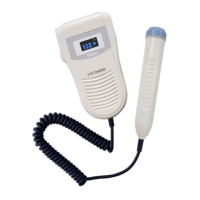Section 3 Operation
3.1 Operation requirements
• The ambient temperature and humidity of the HI • bebe BT-200 should to be
10℃∼40℃ and 30% ~ 85%.
• Handle with care.
• Avoid dust or flammable materials.
• When changing the batteries, make sure the batteries are inserted correctly.
• When detaching the probe from the main body, slide the probe upwards to prevent
damage.
3.2 How to use?
• Turn the power and volume switch counterclockwise to turn the device on and adjust
the volume level.
• Apply a liberal amount of ultrasound gel to the face of transducer (end of the probe).
• Place the transducer directly against the abdomen, just above the point where the
pelvic bones meet.
• Search for the fetal heart by slowly moving the probe around until the fetal heart
sounds are heard.
• Search for the position which can get the clearest heart sound.
3.2.1 HI • bebe BT-200 LCD
• When the input signal is good and stable, FHR will appear on the screen and the solid
heart rhythm indicator will flash as shown in Figure.
• When the input signal is not stable, the outline heart rhythm indicator will flash.
• If the voltage level of battery is lower than the required level, the battery low
message ”bat Lo” will appear. In this case, the unit will not functional correctly and the
batteries should be replaced.
3.2.2 HI • bebe BT-200 Sound
• FHR measuring method : Calculate the FHR for 1 minute.
3.3 Basic clinical information
The fetal heart rate range is normally between 120 – 160 BPM (beats per minute).
When the fetal heart rate remains outside of this normal range for an extended period,
please seek advice from your obstetrician.
3.4 Maintenance and cleaning
To keep clean, wipe the body and probe regularly with an alcohol based clinical wipe.
Do not use the following agents: lacquer, thinner, ethylene or an oxidizing agent as
these could damage the device.
Do not under any circumstances immerse the device in cleaning fluid.

